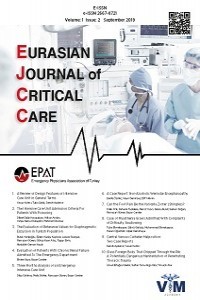Can Caspase 3 Activity Determine Stroke Duration?”
Can Caspase 3 Activity Determine Stroke Duration?”
emergency department, stroke, caspace 3, stroke onset,
___
- References 1. Lo EH, Moskowitz MA, Jacobs TP. Exciting, radical, suicidal: how brain cells die after stroke. Stroke. 2005, s. 36;189-92.
- References 2. Love, S. Apoptozis and Brain İschaemia. Prog. Neuropsychopharmacol. Biol. 2003, s. 267-282.
- References 3. Manabat C, Han B.H, Wendlad M, Derugin N, Fox C.K, Choi J. et al. Reperfusion differentially İnduces Caspase-3 Activation in İschemic Core and Penumbra After Stroke in İmmature Brain., Stroke 34, 2003. s. 207-213.
- References 4. Güleş Ö, Eren Ü. Apoptozisin Belirlenmesinde Kullanılan Yöntemler. Y.Y.Ü. Veteriner Fakültesi Dergisi, 2008. s. 73-78.
- References 5. Li H, Colbourne F, Sun P, Zhao Z, Buchan A.M. Caspase Inhibitors Reduce Neuronal Injury After Focal but Not Global Cerebral Ischemia in Rats. 2000, Stroke, s. 31:176-182.
- References 6. Ferrer I, Planas A.M. Signaling of Cell Death and Cell Survival Following Focal Cerebral Ischemia: Life and Death. Journal of Neuropathology and Experimental Neurology, 2003. s. 329-339.
- References 7. Le D. A, Wu Y, Huang Z, Matsushita K, Plesnila N, Augustinack J. C. Caspase activation and neuroprotection in caspase-3-deficient mice after in vivo cerebral ischemia and in vitro oxygen glucose deprivation. 2018. 10.1073.
- References 8. S. Love, R. Barber, A. Srinivasan, G.K. Wilcock Activation of caspase-3 in permanent and transient brain ischaemia in man. Neuroreport, 2000. s. 2495-2499.
- References 9. Rosell A, Cuadrado E, Avarez-Sabin J, Hernandez-Guillamon M, Delgado P, Penalba A, et al. Caspase-3 is related to infarct growth after human ischemic stroke. Neuroscience Letters, 2008. s. 1-6.
- References 10. Jesper K. Jensen, Søren R. Kristensen, Søren Bak, Dan Atar, Poul Flemming Høilund-Carlsen, at al American Journal of Cardiology, Jan 2007. s. 99:108-12.
- References 11. Bustamante A, López-Cancio E, Pich S, Penalba A, Giralt D, García-Berrocoso T, et al. Blood Biomarkers for the Early Diagnosis of Stroke: The Stroke-Chip Study. Stroke, 2017. s. 2419-2425.
- References 12. Montaner J, Perea-Gainza M, Delgado P, Ribó M, Chacón P, Rosell A, et al. Etiologic diagnosis of ischemic stroke subtypes with plasma biomarkers. Stroke, 2008. s. 39(8):2280-2287.
- References 13. Koç F, Kekeç Z. Neurologic Evaluation of Geriatric Cases Admited to the Emergency Department. Turkish Journal of Geriatrics, Jan 2011, s. 14 (2) 117-121.
- References 14. Kıyan S, Özsaraç M, Ersel M, Aksay E, Yürüktümen A, Musalar E, ve ark. Acil Servise Başvuran Akut İskemik İnmeli 124 Hastanın 1 Yıllık Geriye Dönük İncelenmesi Akademik Acil Tıp Dergisi, Cilt 8, 2009. s. 15-20.
- References 15. Morita N, Harada M, Uno M, Matsubara S, Nagahiro S, Nishitani H. Evaluation of initial diffusion-weighted image findings in acute stroke patients using a semiquantitative score. Magn Reson Med, 2009. s. 8(2):47-53.
- References 16. Youn CS, Choi SP, Kim SH, Oh SH, Jeong WJ, Kim HJ, et al. Serum highly selective C-reactive protein concentration is associated with the volume of ischemic tissue in acute ischemic stroke. Am J Emerg Med, 2012. s. 124-8.
- References 17. Appelros P, Nydevik I, Viitanen M. Poor Outcome After First-Ever Stroke: Predictors for Death, Dependency and Recurrent Stroke Wihin the First Year. Stroke, 2003. s. 34:122-126.
- References 18. Linfante I, Llinas RH, Schlaug G, Chaves C, Warach S, Caplan LR. Diffusion-weighted imaging and National Institutes of Health Stroke Scale in the acute phase of posterior-circulation stroke. 2001. Arch Neurol., s. 621-8.
- References 19. Rami A, Sims J, Botez G, Winckler J. Spatial resolution of phospholipid scramblase 1 (PLSCR1), caspase-3 activation and DNA-fragmentation in the human hippocampus after cerebral ischemia. Neurochem Int., 2003. s. 43: 79-87.
- References 20. J. Montaner M. Mendioroz M. Ribó P. Delgado M. Quintana A. Penalba P. et al. A panel of biomarkers including caspase‐3 and D‐dimer may differentiate acute stroke from stroke‐mimicking conditions in the emergency department. Journal of İnternal Med., Nov 2010. s. 270:166-174.
- References 21. Qi JP, Wu AP, Wang DS, Wang LF, Li SX, Xu FL. Correlation between neuronal injury and Caspase-3 after focal ischemia in human hippocampus. 2004, s. 1507-12.
- References 22. Lynch JR, Blessing R, White WD, Grocott HP, Newman MF, Laskowitz DT. Novel diagnostictest for acute stroke. 2004, Stroke, s. 57-63.
- References 23. Montaner J, Mendioroz M, Ribo M, Delgado P, Quintana M, Penalba A, et al. A Panel of Biyomarkers İncluding Caspase 3 and D-Dimer to Differentiate Acute Stroke from Stroke-Mimicking Conditions in the Emergency Department. Journal of İnternal Medicine, 2011. s. 166-174.
- Başlangıç: 2019
- Yayıncı: Acil Tıp Uzmanları Derneği
THE FILES OF PATIENTS WHO WERE DIAGNOSED WITH DRUG INTOXICATION, RESEARCH LABORATORY ANALYSIS
Ali SARIDAŞ, Basar CANDER, Murat DUYAN
Can Caspase 3 Activity Determine Stroke Duration?”
Sibel GAFUROĞULLARI, Yeşim İŞLER, Halil KAYA, Melih YÜKSEL, Zeynep Nazlı SIR, Yasemin NENNİCİOGLU
Murat DUYAN, Serhat GÜNLÜ, Yıldızhan SOLAÇ, Ali SARIDAŞ, Basar CANDER
A fatal side effect of piperacillin/tazobactam use: a case report.
Murat DUYAN, Serhat GÜNLÜ, Ali SARIDAŞ, Basar CANDER, Yıldızhan SOLAÇ
Vehbi ÖZAYDIN, Alev ECEVİZ, Fatma SARI DOĞAN
Vehbi ÖZAYDIN, Gürkan ERSOY, Elvan ÖÇMEN, Hanife ÇİFTÇİOĞLU YILDIZ, Osman YILMAZ, Necati GÖKMEN, Aslı ÇELİK, Kasım ÖZTÜRK
Acil serviste trombolitik tedavi alan pulmoner tromboemboli hastaların analizi
Emine EMEKTAR, Seda DAĞAR, Hüseyin UZUNOSMANOĞLU, Yunsur ÇEVİK
EMPHYSEMATOUS GASTRITIS – A RARE CAUSE OF PORTO-MESENTERIC VENOUS GAS
